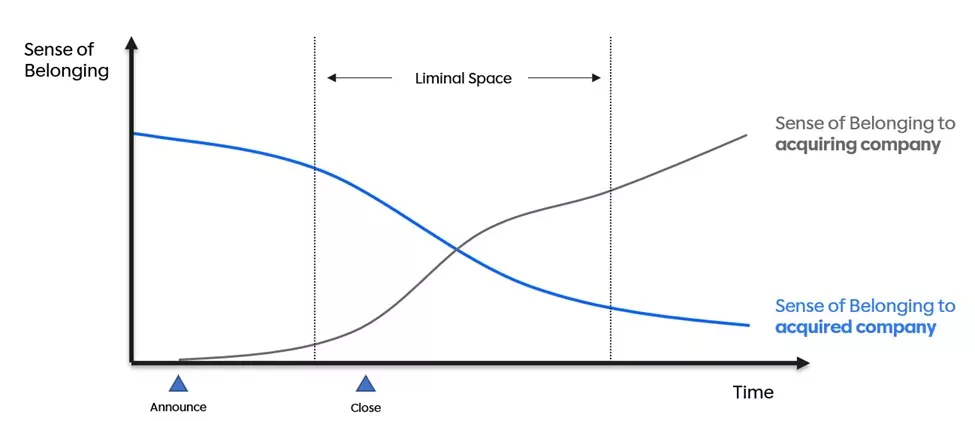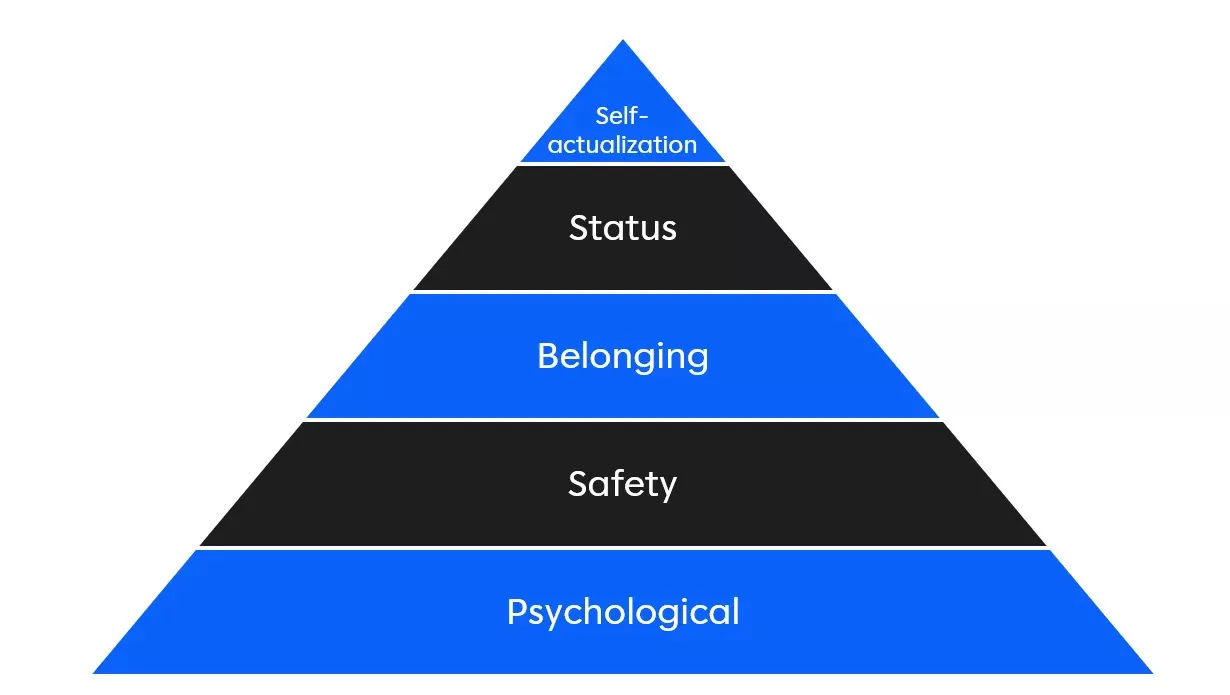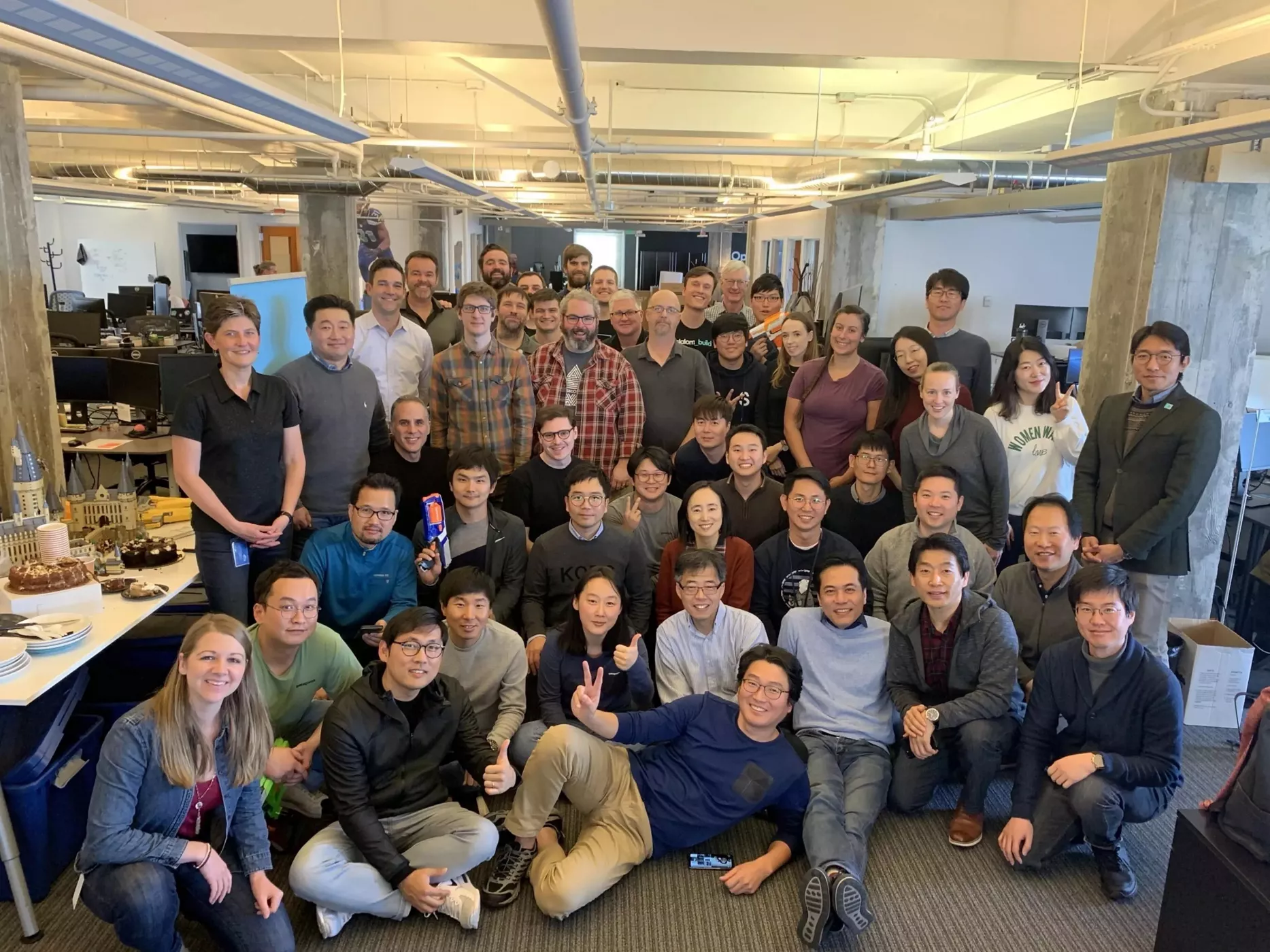10 practices for acquired employee onboarding in M&A

Acquired company employee turnover results in poor deal value realization. A tangible example of this is Okta’s loss in market capitalization of about 30% after announcing higher than the anticipated turnover in the Sales organization of a recent acquisition amongst other reasons.
In this article, we’re examining the role sense of belonging plays in both turnover and engagement. Read on to learn the 10 practices we recommend for acquired companies to counter attrition and drive engagement during the onboarding process.
Attrition, retention, and the need to belong
A 2019 study by the MIT Sloan School puts the average attrition during the first year of acquired company employees at 34% and of hired employees at only 12%. One can argue that if 34% of employees leave, an equal number are looking for another job and are not fully engaged. With these turnover and engagement challenges in mind, it shouldn’t be surprising that most deals struggle to achieve the intended deal objectives. In fact, Harvard Business Review puts the failure rate of mergers and acquisitions (M&A) between 70% and 90%.
Another interesting insight this study provides is the gap in retention between acquired and hired company employees in year one. Following year one, retention rates align between these two groups. This suggests that something is happening in year one that causes acquired company employees to attrit at much higher rates than hired employees.

This blog explains the importance of a “sense of belonging” to the acquiring company and how to structure the onboarding process for acquired company employees to drive retention and engagement.
Baumeister & Leary articulated the “belongingness theory” and call the “need to belong” the most fundamental human motivation. This desire is so universal that the need to belong is found across all cultures and different types of people.
This is true for both hired and acquired company employees. When comparing the average turnover of hired company employees (12%) with acquired company employees (34%), it appears that acquired company employees struggle the most to create a sense of belonging to the new parent company in year one. This is no surprise, as many acquired company employees struggle to transition their sense of belonging from the acquired to the acquiring company.
This transition period is called the “liminal space” — it defines the period where an employee’s association with the acquired company is declining without yet developing a strong sense of belonging to the acquiring company. During this timeframe, an employee is especially vulnerable to exploring outside opportunities and responding to headhunter calls. Headhunters are also known to be eager consumers of M&A news, which signal fertile hunting grounds.

Because “belonging” is an abstract internal psychological state and we can’t see, touch, or measure it, we can only infer belonging from human behavior. Most of us are probably familiar with Maslow’s Hierarchy of Needs, which articulates a motivational theory in psychology. According to Maslow, love and belongingness are key needs that must be satisfied before we can progress on to meet higher-level growth needs.

All this points to the importance of the onboarding process of acquired company employees. But before we dive into best practices for onboarding, it’s important to note that there are three structural differences between acquired and hired employee onboarding:
- Choice — Acquired company employees generally didn’t interview at the acquiring company and therefore didn’t experience the exciting “got the job” moment.
- Workload — Acquired company employees must perform their daily tasks related to their legacy organization to “keep the lights on” while simultaneously attending onboarding training and events. Many are also called upon to support integration activities, which can easily lead to burnout.
- Environment — Hired employees are usually surrounded by teams with tenure at the organization, enabling them to receive informal support and encouragement. Acquired company employees, however, often transition into the acquiring company as a team and are thereby surrounded by colleagues who are also new to the organization.
Most companies use the new-hire onboarding process for acquired company employees with a few modifications. As the data from MIT Sloan School indicates, this is insufficient, as it doesn’t address sense of belonging as a key driver for retention and engagement.
Best practices for acquired employee onboarding
1. Cascade onboarding
Ensure that there’s a structured onboarding process across all levels of the organization. Most companies do a good job of onboarding employees at the company level, including introductions to company values, HR benefits, compliance training, end-user computing, and productivity tools. However, onboarding at the functional and team levels is less structured since it primarily relies on on-the-job training.
2. Integration roadmap
Develop a detailed integration roadmap, which spells out when functions and teams are coming together. Not all functions are integrated at the same time—often general and administrative (G&A) functions are integrated first, followed by Go-to-Market (GTM) functions and engineering functions. Having a clear roadmap enables acquired company employees to understand how they’re being integrated into the organization and puts their onboarding experience into context.
3. Employee experience
Use Design Thinking principles to create “Moments of Truth”, which define the onboarding experience of acquired company employees. The onboarding process is a unique opportunity to introduce acquired company employees to the culture and values of the organization. For example, if customer centricity is a key value of the organization, the onboarding experience should reflect that and highlight how the acquiring company is creating “customer delight” with everything they do.
4. Change overload
Create an integrated change impact roadmap and ensure integration workstreams driving change in a consistent and coordinated fashion. Without creating visibility across integration tracks of all the changes, it’s easy to arrive at a state of overload. Best-in-class acquirers create impact heatmaps that show which employee group is being stretched and devise strategies and communications to mitigate risk. This includes hiring temporary employees to lessen the burden and giving impacted stakeholder groups notice about upcoming changes.
5. Leadership participation
The role of acquired company leaders as catalysts for change and stewards to create a sense of belonging cannot be understated. In general, the ability to contribute is often mentioned as one of the biggest drivers to creating a sense of belonging. A common mistake is not sufficiently including acquired company leaders in integration planning and execution. Change is most likely to be successful when it is done with them and not to them. However, it’s important to strike a fine balance and not overload acquired company leaders, since they’ll be going through the liminal space themselves.
6. Onboarding playbooks
Most companies that are growing through acquisitions have M&A playbooks. These playbooks should also include a detailed outline of the onboarding process both at company and functional levels. The documentation of high-level processes for each function is important not just for process integration, but also serves as an enabler for functional onboarding.
7. “Long-boarding”
Think of onboarding not as an event, but as a journey. Therefore, acquired company employee onboarding can be referred to as “long-boarding.” Many organizations create onboarding plans that cover three to six months. To create a sense of belonging at all levels, a more reasonable timeframe is at least 100 days after day one.
8. Onboarding workstream
Onboarding is a cross-functional activity driven by the Integration Management Office (IMO), which includes every integration workstream. The onboarding workstream focuses on creating a consistent onboarding experience and functions as the control center, ensuring that the desired employee experience is delivered.
9. Listening posts
In M&A, things move quickly and there is little time to react. An increase in turnover suggests that things have been going in the wrong direction for a while. Therefore, it’s imperative to create “listening posts” that enable the IMO and integration leadership team to understand the sentiment of acquired company employees. Listening posts include 30/60/90-day surveys and other mechanisms, such as change agent networks, number of calls to the support center, sick leave, customer satisfaction metrics, and more.
10. Support
Create a support hotline for acquired company employees. The most obvious need for support is to help them learn the acquired company systems. These hotlines should be cross-staffed with the acquired company’s IT staff since they know the legacy systems and can easily put the new in the context of the old. Additional hotlines can then be created by function, such as sales enablement.
Conclusion
Creating a positive experience during onboarding for acquired company employees is not just a nice-to-have—it’s critical to deal value realization. It also provides a template for leaders to estimate their capacity for onboarding an acquired organization. After all, improving the onboarding process of acquired company employees will also improve the onboarding experience of hired employees, ultimately reducing turnover and driving a sense of belonging across the organization.
This blog post was originally published here.



